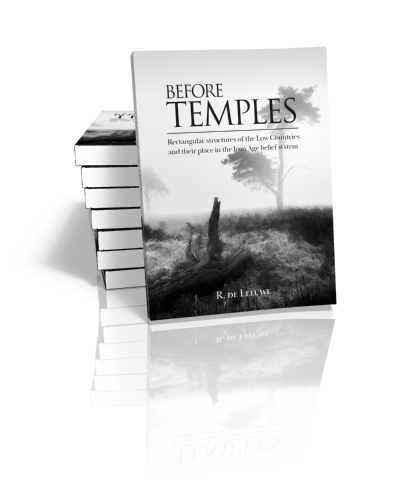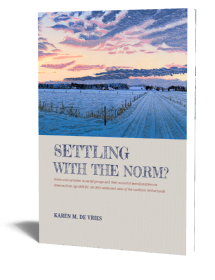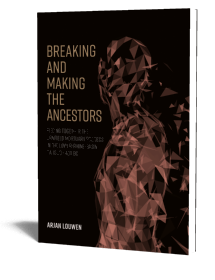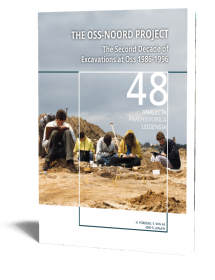Before Temples
Rectangular structures of the Low Countries and their place in the Iron Age belief system
R. de Leeuwe | 2023

Before Temples
Rectangular structures of the Low Countries and their place in the Iron Age belief system
R. de Leeuwe | 2023
Paperback ISBN: 9789464280609 | Hardback ISBN: 9789464280616 | Imprint: Sidestone Press Dissertations | Format: 210x280mm | 284 pp. | Language: English | 61 illus. (bw) | 74 illus. (fc) | Keywords: archaeology; Iron Age; religion; ritual; Low Countries; viereckschanze | download cover | DOI: 10.59641/4u9131xg
Read online 432 times
- Digital & Online access
-
Buy via Sidestone (EU & UK)
-
Buy via our Distributors (WORLD)
For non-EU or UK destinations you can buy our books via our international distributors. Although prices may vary this will ensure speedy delivery and reduction in shipping costs or import tax. But you can also order with us directly via the module above.
UK international distributor
USA international distributor
-
Bookinfo
Paperback ISBN: 9789464280609 | Hardback ISBN: 9789464280616 | Imprint: Sidestone Press Dissertations | Format: 210x280mm | 284 pp. | Language: English | 61 illus. (bw) | 74 illus. (fc) | Keywords: archaeology; Iron Age; religion; ritual; Low Countries; viereckschanze | download cover | DOI: 10.59641/4u9131xg
Read online 432 times

We will plant a tree for each order containing a paperback or hardback book via OneTreePlanted.org.
Before the introduction of Roman temples in the Low Countries, there used to be ‘open air cult places’ in the Iron Age. That is at least the assumption based on descriptions given by classical writers and several structures typified as sanctuaries that were excavated in France.
Several of these French sanctuaries portray long usage, modifications, disarticulated human remains, and depositions of animal bones and Iron Age weaponry. However, the regularly encountered rectangular structures in Belgium and the Netherlands that are often interpreted as cult places do not have any of these indicators. Even though the shape is similar, the evidence these structures deliver testifies to short term utilisation, pottery depositions and a vaguely defined relation to cremation graves.
Can these structures and accompanying depositions be perceived as the result of actions to invoke gods or deities as is claimed for the French sanctuaries? The finds and features seem more suitable when the rectangular structures are interpreted as part of ancestral worship. Although, what does that actually entail? How did Iron Age people actually conceptualise or practise interaction with ancestral spirits?
In this thesis the use of rectangular structures during the Iron Age is explored and the meaning of related depositions interpreted. The structures fulfilled a special sociocultural position in Iron Age society, emphasised by the deliberately chosen liminal location in an increasingly structured landscape.
1 Introduction
1.1 Prologue: a semantic problem
1.2 The problem of interpreting a rectangular structure
1.3 The problem of the ‘ritual’ in a rectangular structure
1.4 The problem of the environmental context and date of a rectangular structure
1.5 Research questions
1.6 Dataset and limitations
1.7 Variables
1.8 Approach and outline of the study
2 The belief system in the Iron Age
2.1 Introduction
2.2 The soul and the ancestors
2.3 Phenomenology and the natural world
2.4 The ‘ritual of exchange’
2.5 Objects of exchange
2.6 Before temples: a place for depositions
2.7 Conclusion
3 Geographical framework: the ‘archaeotypical’ sanctuary
3.1 Introduction
3.2 The sanctuaries of Northern France
3.3 The rectangular structures of Germany
3.4 Shrines, enclosures and causeways in England
3.5 Conclusion
4 Rectangular structures in the Late Bronze Age – Early Iron Age
4.1 Introduction
4.2 Rectangular structures in urnfields
4.3 Rectangular structures in Early Iron Age settlements
4.4 Conclusion: the urnfield as a point of origin
5 Rectangular structures in the Middle Iron Age
5.1 Introduction
5.2 Burial traditions and the treatment of human remains
5.3 The 5th century BCE
5.4 Rectangular structures and their relation to graves
5.5 Discussion on rectangular structures in the Middle Iron Age
5.6 Conclusion
6 Rectangular structures in the Late Iron Age
6.1 Introduction
6.2 Transition into the Late Iron Age
6.3 Continuation of burial traditions
6.4 Rectangular structures and field systems
6.5 Diverse use and variable contexts of rectangular structures
6.6 Synthesis: the varied use of rectangular structures in the Late Iron Age
6.7 Conclusion
7 The environment and context of rectangular structures
7.1 Introduction
7.2 Aalter-Woestijne
7.3 Harelbeke and Kortrijk
7.4 Oss-Ussen
7.5 Diachronic landscape use and the rectangular structure
8 The function of a rectangular structure
8.1 Introduction
8.2 The rectangular structure as a functional earthwork
8.3 The rectangular structure as a cemetery demarcation
8.4 The rectangular structure as a symbolic boundary
8.5 The rectangular structure as a deposition space
8.6 The rectangular structure as a liminal place
8.7 Epilogue: evaluating Oss-Brabantstraat
9 Conclusion
9.1 Iron Age beliefs
9.2 Warriors and missing persons
9.3 A place for communication
9.4 Some answers and more questions

Dr. R. de Leeuwe
After finishing a Bachelor degree in Maritime Engineering in 1996 at the Rotterdam University of Applied Sciences, Roosje worked on stability calculations for drilling rigs and technical designing for several engineering agencies for a couple of years. In 1998 she started studying Archaeology at Leiden University, besides work. During her studies she gained fieldwork experience in the Netherlands, Mali, Malawi, and Tanzania. In 2003, the final year of prehistoric studies, with a specialization in maritime archaeology, she started to work at Archol, a commercial archaeological company attached to Leiden University. In 2004 she got a Master degree in Archaeology with a thesis on East African ship building traditions. After working for 8.5 years as a field archaeologist, she changed in 2011 to working as a forensic archaeologist at the Netherlands Forensic Institute. The work there involved case investigations commissioned by the police and judicial authorities such as the International Tribunal in The Hague, research and development related to missing persons, buried victims, crime scene investigation and identification. In 2017 she changed back to field archaeology and since works as a project manager at RAAP West conducting archaeological research in Central and West-Netherlands. In 2023 she received a PhD in archaeology for her thesis ´before temples´, on structures related to the Iron Age belief system in the Low Countries.
Abstract:
Before the introduction of Roman temples in the Low Countries, there used to be ‘open air cult places’ in the Iron Age. That is at least the assumption based on descriptions given by classical writers and several structures typified as sanctuaries that were excavated in France.
Several of these French sanctuaries portray long usage, modifications, disarticulated human remains, and depositions of animal bones and Iron Age weaponry. However, the regularly encountered rectangular structures in Belgium and the Netherlands that are often interpreted as cult places do not have any of these indicators. Even though the shape is similar, the evidence these structures deliver testifies to short term utilisation, pottery depositions and a vaguely defined relation to cremation graves.
Can these structures and accompanying depositions be perceived as the result of actions to invoke gods or deities as is claimed for the French sanctuaries? The finds and features seem more suitable when the rectangular structures are interpreted as part of ancestral worship. Although, what does that actually entail? How did Iron Age people actually conceptualise or practise interaction with ancestral spirits?
In this thesis the use of rectangular structures during the Iron Age is explored and the meaning of related depositions interpreted. The structures fulfilled a special sociocultural position in Iron Age society, emphasised by the deliberately chosen liminal location in an increasingly structured landscape.
Contents
1 Introduction
1.1 Prologue: a semantic problem
1.2 The problem of interpreting a rectangular structure
1.3 The problem of the ‘ritual’ in a rectangular structure
1.4 The problem of the environmental context and date of a rectangular structure
1.5 Research questions
1.6 Dataset and limitations
1.7 Variables
1.8 Approach and outline of the study
2 The belief system in the Iron Age
2.1 Introduction
2.2 The soul and the ancestors
2.3 Phenomenology and the natural world
2.4 The ‘ritual of exchange’
2.5 Objects of exchange
2.6 Before temples: a place for depositions
2.7 Conclusion
3 Geographical framework: the ‘archaeotypical’ sanctuary
3.1 Introduction
3.2 The sanctuaries of Northern France
3.3 The rectangular structures of Germany
3.4 Shrines, enclosures and causeways in England
3.5 Conclusion
4 Rectangular structures in the Late Bronze Age – Early Iron Age
4.1 Introduction
4.2 Rectangular structures in urnfields
4.3 Rectangular structures in Early Iron Age settlements
4.4 Conclusion: the urnfield as a point of origin
5 Rectangular structures in the Middle Iron Age
5.1 Introduction
5.2 Burial traditions and the treatment of human remains
5.3 The 5th century BCE
5.4 Rectangular structures and their relation to graves
5.5 Discussion on rectangular structures in the Middle Iron Age
5.6 Conclusion
6 Rectangular structures in the Late Iron Age
6.1 Introduction
6.2 Transition into the Late Iron Age
6.3 Continuation of burial traditions
6.4 Rectangular structures and field systems
6.5 Diverse use and variable contexts of rectangular structures
6.6 Synthesis: the varied use of rectangular structures in the Late Iron Age
6.7 Conclusion
7 The environment and context of rectangular structures
7.1 Introduction
7.2 Aalter-Woestijne
7.3 Harelbeke and Kortrijk
7.4 Oss-Ussen
7.5 Diachronic landscape use and the rectangular structure
8 The function of a rectangular structure
8.1 Introduction
8.2 The rectangular structure as a functional earthwork
8.3 The rectangular structure as a cemetery demarcation
8.4 The rectangular structure as a symbolic boundary
8.5 The rectangular structure as a deposition space
8.6 The rectangular structure as a liminal place
8.7 Epilogue: evaluating Oss-Brabantstraat
9 Conclusion
9.1 Iron Age beliefs
9.2 Warriors and missing persons
9.3 A place for communication
9.4 Some answers and more questions

Dr. R. de Leeuwe
After finishing a Bachelor degree in Maritime Engineering in 1996 at the Rotterdam University of Applied Sciences, Roosje worked on stability calculations for drilling rigs and technical designing for several engineering agencies for a couple of years. In 1998 she started studying Archaeology at Leiden University, besides work. During her studies she gained fieldwork experience in the Netherlands, Mali, Malawi, and Tanzania. In 2003, the final year of prehistoric studies, with a specialization in maritime archaeology, she started to work at Archol, a commercial archaeological company attached to Leiden University. In 2004 she got a Master degree in Archaeology with a thesis on East African ship building traditions. After working for 8.5 years as a field archaeologist, she changed in 2011 to working as a forensic archaeologist at the Netherlands Forensic Institute. The work there involved case investigations commissioned by the police and judicial authorities such as the International Tribunal in The Hague, research and development related to missing persons, buried victims, crime scene investigation and identification. In 2017 she changed back to field archaeology and since works as a project manager at RAAP West conducting archaeological research in Central and West-Netherlands. In 2023 she received a PhD in archaeology for her thesis ´before temples´, on structures related to the Iron Age belief system in the Low Countries.
- Digital & Online access
-
Buy via Sidestone (EU & UK)
-
Buy via our Distributors (WORLD)
For non-EU or UK destinations you can buy our books via our international distributors. Although prices may vary this will ensure speedy delivery and reduction in shipping costs or import tax. But you can also order with us directly via the module above.
UK international distributor
USA international distributor
- Browse all books by subject
-
Search all books

We will plant a tree for each order containing a paperback or hardback book via OneTreePlanted.org.
You might also like:
© 2025 Sidestone Press KvK nr. 28114891 Privacy policy Sidestone Newsletter Terms and Conditions (Dutch)








